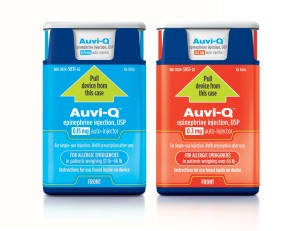Sanofi announced today that Auvi-Q™ (epinephrine injection, USP) is
now available in U.S. retail pharmacies nationwide with a prescription
from a healthcare provider.
Auvi-Q is the first-and-only
epinephrine auto-injector with audio and visual cues for the emergency
treatment of life-threatening allergic reactions in people who are at
risk for or have a history of anaphylaxis. The size and shape of a
credit card and the thickness of a smart phone, Auvi-Q is a breakthrough
in epinephrine auto-injector device design that talks patients and
caregivers step-by-step through the injection process.
"Patient feedback was a critical component to the development process for Auvi-Q," said Anne Whitaker, President, North America Pharmaceuticals, Sanofi.
"The
availability of Auvi-Q represents an important step forward in our
continued innovation to meet the needs of people at risk for anaphylaxis and their caregivers."

Up
to six million Americans may be at risk for anaphylaxis, although the
precise incidence is unknown and likely under-reported. While guidelines
emphasize the importance of the life-saving role of epinephrine, two
large surveys
show that two-thirds of patients and caregivers do not carry their
epinephrine auto-injectors as recommended, and nearly half worry that
others will not know how to use their or their child's epinephrine
auto-injector correctly during an emergency.
Multiple studies have found
an association between delay in epinephrine administration and death
from anaphylaxis.
Life-threatening allergic reactions may occur as
a result of exposure to allergens including foods such as peanuts, tree
nuts, fish, shellfish, dairy, eggs, soy and wheat; insect stings; latex
and medication, among other allergens and causes.
About Auvi-Q
Auvi-Q
provides users with audible and visual cues, including a five-second
injection countdown and an alert light to signal when the injection is
complete. Auvi-Q also features an automatic retractable needle mechanism
to help prevent accidental needle sticks.
Available in two
different dosages, Auvi-Q 0.3mg delivers 0.3mg epinephrine injection and
is intended for patients who weigh 66 pounds or more. Auvi-Q 0.15mg
delivers 0.15mg epinephrine injection and is intended for patients who
weigh 33 – 66 pounds. Auvi-Q has not been studied in patients weighing
less than 33 pounds. Each Auvi-Q pack contains two devices - containing
one dose of epinephrine each - and a non-active training device. Auvi-Q
received U.S. Food and Drug Administration approval in August 2012.
Sanofi
US licensed the North America commercialization rights to Auvi-Q from
Intelliject, Inc., which has retained commercialization rights for the
rest of the world. Eric and Evan Edwards, twin brothers who suffer from
life-threatening allergies, and co-founders of Intelliject, Inc.,
developed Auvi-Q with a team of world class engineers and scientists.
The development process incorporated real-world experiences and feedback
from patients and caregivers.
Auvi-Q has been named an
International CES Innovations 2013 Design and Engineering Awards
Honoree.
Indication
Auvi-Q
(epinephrine injection, USP) is used to treat life-threatening allergic
reactions (anaphylaxis) in people who are at risk for or have a history
of these reactions.
Important Safety Information
Auvi-Q
is for immediate self (or caregiver) administration and does not take
the place of emergency medical care. Seek immediate medical treatment
after use. Each Auvi-Q contains a single dose of epinephrine.
Auvi-Q should only be injected into your outer thigh.
DO NOT INJECT INTO BUTTOCK OR INTRAVENOUSLY. If you accidentally inject
Auvi-Q into any other part of your body, seek immediate medical
treatment. Epinephrine should be used with caution if you have heart
disease or are taking certain medicines that can cause heart-related
(cardiac) symptoms.
If you take certain medicines, you may develop serious life-threatening side effects from epinephrine.
Be sure to tell your doctor all the medicines you take, especially
medicines for asthma. Side effects may be increased in patients with
certain medical conditions, or who take certain medicines. These include
asthma, allergies, depression, thyroid disease, Parkinson's disease,
diabetes, high blood pressure, and heart disease.
The most common
side effects may include increase in heart rate, stronger or irregular
heartbeat, sweating, nausea and vomiting, difficulty breathing,
paleness, dizziness, weakness or shakiness, headache, apprehension,
nervousness, or anxiety. These side effects go away quickly, especially
if you rest.
Talk to your healthcare professional to see if Auvi-Q is right for you.
About Anaphylaxis
The
signs and symptoms of anaphylaxis can vary from person to person and
from one episode to the next. Some people may have hives/itching, facial
or tongue swelling, which makes it difficult to breathe or swallow,
while others may experience nausea and vomiting. These symptoms may
begin within seconds, minutes or hours after exposure to the allergen.
The best prevention method for anaphylaxis is avoidance of the specific
allergen(s).
When a severe, life-threatening allergic reaction
occurs, epinephrine should be administered immediately and patients and
caregivers should seek immediate medical attention. Patients and
caregivers should always carry and know how to use an epinephrine
auto-injector to treat emergency allergic reactions. Without treatment,
anaphylaxis can result in death within a matter of minutes.
About Sanofi
Sanofi,
a global and diversified healthcare leader, discovers, develops and
distributes therapeutic solutions focused on patients' needs. Sanofi has
core strengths in the field of healthcare with seven growth platforms:
diabetes solutions, human vaccines, innovative drugs, rare diseases,
consumer healthcare, emerging markets and animal health. Sanofi is
listed in Paris (EURONEXT: SAN) and in New York (NYSE: SNY).
Sanofi
is the holding company of a consolidated group of subsidiaries and
operates in the United States as Sanofi US, also referred to as
Sanofi-aventis U.S. LLC. For more information on Sanofi US, please visit
Sanofi or call
1-800-981-2491.
UPDATE: In late October 2015, Sanofi US recalls all Auvi-Q and Allerject devises. Will let you know as soon as they get back in the market. We hope to see them back soon
by: Marlena Delgado Coen















